EPCOT Center’s path from concept to execution was, in so many ways, far more tortured than most Disney fans know. Far from a merely difficult transition from Walt’s concept for a futuristic city to a permanent World’s Fair (or, as modern revisionists would have it, a straight shot from Walt’s mind to the park that opened in 1982), EPCOT’s development occupied the full span of the 1970s and in that time took a number of different forms. EPCOT, in one form or another, was announced on several different occasions – often with great fanfare. But as disjointed as this development process might seem, in retrospect it follows a clear evolution, with concepts changing and merging but core themes remaining throughout.
The ideals that would underpin EPCOT Center were formulated early in the 1970s and grew fairly organically from Walt’s ambitions for EPCOT city; each variation of the EPCOT concept derived its mission, in some fashion, from these ideals. The first of these points was that Walt Disney World itself was, in a way, EPCOT, and would provide a living laboratory for a number of innovative technologies and systems. A second goal for EPCOT centered on the international community, and on ways to bring various cultures together in one place; plans for a World Showcase were in fact the first elements of EPCOT announced for construction in the early 1970s.
The other key aspects of EPCOT, of course, would involve the creation of a futuristic “community” that would allow the public to encounter new technologies and to see how these ideas and innovations would shape their lives in the future. Key to this element of EPCOT would be the involvement of major American corporations, as the Disney organization under Card Walker believed that only American free enterprise held the answers for the problems facing our communities and when given free reign (as Disney itself had been in its self-governed Reedy Creek Improvement District) these corporations could and would address these problems head-on.
Concepts to embody the futuristic aspects of EPCOT’s goals took longer to develop, only truly emerging with some of Card Walker’s EPCOT Center announcements in 1975. As we’ve mentioned previously, this “EPCOT Future World Theme Center” would have been an entirely separate gate from the World Showcase and was the first publicly-announced version of what would evolve into EPCOT Center’s Future World.
Of course, at the time this was intended to be only one of the EPCOT “Theme Centers.” These “centers” of activity (also, on occasion, referred to as “Satellites”) are vaguely mentioned through the years as places where public and private researchers could interact and meet to address society’s ills, all under the watchful eyes of thousands of daily visitors. In fact, it’s occasionally mentioned that these Centers would stretch beyond the borders of Walt Disney World and to various research locations nationwide. It was with an eye towards this goal that Disney held a number of academic conferences under the EPCOT name during the 1970s, focusing on subjects ranging from future technology to health care. Eventually these “Theme Centers” would be abandoned, and they were replaced with a single concept – EPCOT Center.
Obviously, something happened between these early visions and the announcement in 1978 of a theme park that is recognizably EPCOT Center. There’s always been the famous story of Marty Sklar and John Hench, staring down the barrel of an impending visit from Disney executives, pushing the World Showcase and Future World models together to form a single park. But even that tale belies a more complicated truth. The first time the World Showcase and Future World ideas were combined into a single gated attraction appears to be sometime in 1976. But, at the time, the park’s layout was far different, and reversed – guests would enter the park through World Showcase, which would serve as a sort of international Main Street before guiding visitors into the technological realm of Future World. Looking at the plans from the period, it’s clear Disney was still trying to work out a single clear vision for the park. Finally, in 1977, things would start to click into place.
With great fanfare, the 1977 Walt Disney Productions Annual Report rather breathlessly heralds the “conceptual breaktrough” of Master Plan 5 – their newest vision of what EPCOT Center would be. To quote CEO Card Walker’s letter to shareholders:
There has never been a greater need for the communication of information about the diverse peoples of our planet, the new systems and technologies evolving to meet the needs of those people, and the alternative decisions we face. Our future depends upon it. For the better we understand today, the choices for tomorrow, the better decisions we will make.
This is what EPCOT Center and its two major themes, Future World and the World Showcase, will be devoted to: the advancement of international understanding and the solution of the problems of people everywhere – through the communication of ideas.
Our dedication to this concept will not be limited to the EPCOT Center site in Florida. It will extend as far as the Disney ability to communicate can reach, including films, television, educational materials and even the licensing of concepts and products. For this reason, we believe, EPCOT Center can open an exciting new dimension for Walt Disney Productions.
At this writing, for example, a series of five television specials exploring each of EPCOT Center’s wide-ranging themes is under development. Our preliminary plans are to inaugurate this series with a gala “Disney Week” on television, recreating the career and dreams of Walt Disney, culminating in a major special on “Walt Disney’s Greatest Dream: EPCOT.”
However, as we have consistently pointed out, EPCOT Center cannot and should not move forward on the financial or creative strength of any one organization. It requires the best thinking and financial support of American industry and the commercial and government interest of other nations as well.
Therefore, while our creative people have been developing the conceptual breakthrough for EPCOT Center, we have continued to seek support for the first phase of World Showcase from foreign industry and governments around the world. Our efforts have included Canada, Costa Rica, England, Israel, Japan, Mexico, Morocco, Poland, Saudi Arabia, South Korea, United Arab Emirates, Venezuela, West Germany, and other countries. Several of these have already indicated their intention to participate as sponsors of pavilions and exhibits in the World Showcase. Others are in varying stages of negotiations which we feel will lead to their participation.
Over the past few months, we have begun to emphasize our concept for EPCOT Center’s Future World. We have discussed the first phase development with such major American corporations as American Telephone & Telegraph, ARCO, Borden, Coca-Cola, Exxon, General Electric, General Motors, IBM, RCA, Sperry Rand, Standard Oil of Indiana, Westinghouse, and others. The initials response from these corporations has been most enthusiastic. And we have entered into negotiations with a number of them which we feel will result in their participation as sponsors of pavilions and exhibits in Future World. We believe EPCOT Center has stimulated many of America’s leading corporations because the EPCOT dynamic is really the America dynamic. It is founded on the principles of American enterprise – and a belief that an informed public can, and will, make better decisions for tomorrow if they understand and believe accurate and relevant information today.
So, you know, no pressure.
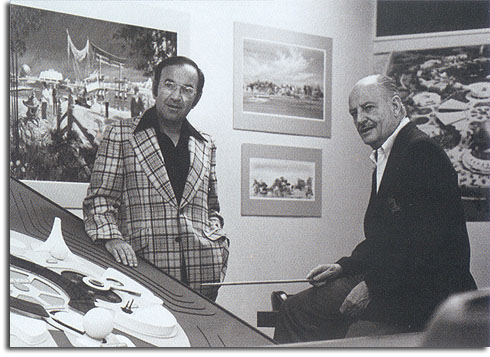 Imagineers Marty Sklar and John Hench with a dimensional model of the 1977 park layout seen above. Note the later, 1978 rendering of the park on the wall behind them.
Imagineers Marty Sklar and John Hench with a dimensional model of the 1977 park layout seen above. Note the later, 1978 rendering of the park on the wall behind them.What’s interesting about Walker’s statement, aside from the list of nations and sponsors who would never join the EPCOT ranks, is how he adheres so strictly to those core EPCOT ideals. As the Disney report would later state:
As conceived here, EPCOT will be a “Showcase for prototype concepts,” demonstrating practical applications of new ideas and systems from creative centers everywhere. It will provide an “on-going forum of the future,” where the best thinking of industry, government and academia is exchanged to communicate practical solutions to the needs of the world community. It will be a “communicator to the world,” utilizing the growing spectrum of information transfer to bring new knowledge to the public. Finally, EPCOT will be a permanent “international people-to-people exchange,” advancing the cause of world understanding.
In addition, we are convinced that EPCOT will provide a much needed symbol of hope and optimism that our major challenges can, and will be met. It will provide outstanding family entertainment from which people may draw enlightenment, as well as enjoyment. And it will, of course, represent a major new extension of our business activities around the world.
It also seems clear that Future World has entered development much more recently than World Showcase; surprisingly, though, the vision described for that area hews very closely on a pavilion-by-pavilion basis to the park that opened in 1982. World Showcase, as you can see from the models above, actually took the form of a double promenade, providing far more open space for potential national pavilions than the final layout. The American Adventure, labeled on the model as “U.S.A.”, sits not at the far end of the World Showcase lagoon, but instead straddles the path from Future World to World Showcase. It would remain in this spot until 1979. But even Disney, proud as they are to promote the success of Master Plan 5, acknowledge that things remain in flux:
As we proceed with our planning for the EPCOT project, the specifics of this plan will, undoubtedly, change time and time again. This is a natural result of the Disney creative process which continually probes for the best alternative. Disneyland, for example, was constructed from Master Plan 67. the Walt Disney World complex, which more than 71 million people have visited, grew out of our 17th Master Plan.
However, the basic concepts contained here will remain substantially the same. For the two major themed areas, “Future World” and the “World Showcase,” together with the “American Adventure,” which acts as a gateway between the world of today and tomorrow, provide what we believe are the best opportunities for meeting the four major objectives we have established to bring Walt Disney’s last and greatest dream to reality.
It seemed, at last, that the Imagineers had found a concept that they liked. So let’s take a look around EPCOT Center in 1977; a familiar yet strangely different park, which is still strongly defined by the divide between its two sections: Future World and World Showcase.
Future World
Future World, as you can see, was starting to take a recognizable shape even at this time. Spaceship Earth is in its proper place, as was Communicore. Going clockwise from the bottom left, where today we’d find the Universe of Energy, we have “Life & Health,” “The Land,” “Transportation,” “U.S.A.” (The American Adventure), “Space,” “The Sea,” and “Energy”. If you removed American Adventure, that’s the same number of pavilions that EPCOT Center would feature in its actual phase one, although only Spaceship Earth, Communicore, and “Transportation” – later World of Motion – would remain in their current spots throughout development. The fact that General Motors signed on as EPCOT’s first sponsor in 1978 meant that the Transportation pavilion got a big head start, and if you look at EPCOT construction photos from 1979-1982 you’ll note that the World of Motion is always much farther along in construction than other pavilions. But what’s in this Future World?
The Future World, an American enterprise forum, poses the challenges and previews alternatives for the “Community of the Future.” The principal components of Future World include: A major introductory theme show, Spaceship Earth; the Communicore, a global marketplace of new ideas bringing the public into direct interface with industry; and a series of major pavilions exploring Energy, Life & Health, The Sea, The Land, Transportation, and Space.
The park’s central icon, then as now, was Spaceship Earth. The grand mirrored orb had yet to sprout legs, though, and was not a geosphere – merely a geodome. Judging by artwork and models, a great deal of the attraction would take place in a show building behind the geosphere, not in the dome itself.
 “EPCOT INTRODUCTION: Standing at the entrance to EPCOT Center, Spaceship Earth will introduce guests to the concept and meaning of the project.”
“EPCOT INTRODUCTION: Standing at the entrance to EPCOT Center, Spaceship Earth will introduce guests to the concept and meaning of the project.”Spaceship Earth
Spaceship Earth is the major theme show and introduction to the concept and meaning of EPCOT, focusing on the relationship between communications and humankind’s continuing dynamic – survival. It is an optimistic statement recognizing our enormous challenges and concluding strongly that creative men and women of the world can develop a viable “instruction book for Spaceship Earth.”
Central to the meaning of the show is the fact that access to accurate and relevant information and the continuing ability to create new and better tools for survival have been the real dynamic of our voyage aboard Spaceship Earth.The Disney staff is creating an exciting and unique theatrical experience for the dramatic spherical structure which will dominate the entrance into EPCOT Center. A time machine journey into the past to trace man’s progress as he acquires and utilizes new knowledge. Surging forward through time, guests will see historical milestones unfold as man records, communicates more broadly and finally uses computer technology to process ever increasing amounts of information.
As the Spaceship Earth show concludes, the audience is invited to go forth into EPCOT’s Future World, into the many pavilions offering dramatic new vistas into vitally important topics affecting the future of humankind.
Communicore
As you can probably see from these renderings, Communicore was intended as a much more vibrant and vital section of Future World than it ever was in actuality, and certainly much more so than Innoventions is today. Communicore was the community – and communications – core of EPCOT, and it would be the place where guests would synthesize the information from the various theme pavilions and interact with these new futuristic concepts in relatable ways.
As its name suggests, this global marketplace of new ideas will be the communications core of EPCOT Center. Here, industry and the public will participate in a “hands on” exchange of new and exciting ideas, systems, products and technologies.
 “FUTURE WORLD TRAVEL PORT: This artist concept depicts a Communicore attraction where guests will electronically preview their vacations.” (Note the Mark III Monorail in the background)
“FUTURE WORLD TRAVEL PORT: This artist concept depicts a Communicore attraction where guests will electronically preview their vacations.” (Note the Mark III Monorail in the background)Some of the beginning concepts for this “information marketplace” include:
Telstore – a Future World “video bookstore” where guests could experience first-hand the newly emerging world of video information for the home.
Future World Travel Port – an electronic travel port where visitors could “dial-in” their travel interests and other itinerary requirements and watch an “instant preview” of their upcoming vacation.
FuturePlan – a career center concept where immediate information would be offered about careers for young people and the newly developing field of second careers for retiring citizens.
Informat Arcade – a concept providing new experiences for the public in information retrieval, which would include a “Casino of information” in game-playing format … taking the penny arcade of the past into the information age.
Other ideas for the Communicore will be developed by joint task forces of Disney designers and industry participants and may include such things as The Good Health Emporium, the drug store of tomorrow and The Future World Office, a paperless place of business.
The drug store of tomorrow? A career center? The penny arcade of the information age? As you can see, Communicore would have been a much different place had these plans gone through; it would have certainly served more as a futuristic mirror to Disneyland’s Main Street, U.S.A. Although I have to say, I’m intrigued by this “paperless place of business” of which they speak…
Life & Health Pavilion
 “The study model of the Life & Health Pavilion includes an area offering guests a ride through the fantastic wonders of the body and The Great Midway of Life, where they will learn their personal responsibility for good health habits.”
“The study model of the Life & Health Pavilion includes an area offering guests a ride through the fantastic wonders of the body and The Great Midway of Life, where they will learn their personal responsibility for good health habits.”This pavilion, though obviously long planned, was also a long time coming for EPCOT fans. A health-themed pavilion would not actually open in the park until 1989, when Wonders of Life debuted. Still, as you might be able to tell, that pavilion drew a great deal of inspiration from these early plans. The interior of the pavilion would have had a very whimsical design, courtesy of veteran Imagineer Rolly Crump. Guests would enter “The Great Midway of Life” in the central circular area, around which were a number of shows and experiences. Some of these would later have analogous attractions in the similarly circular Wonders of Life building.
While a more thorough exploration of this abandoned pavilion will have to wait for a future post, I would like to point out the various attractions in the model. After entering on the right-hand side of the picture, guests moving clockwise would encounter The Joy of Living, a sensory funhouse (at the bottom of the photo), the Tooth Follies, The Head Trip (which would eventually become Cranium Command), Good Health Habits, and, in the large angular show building at the top of the picture, The Incredibly Journey Within. This massive dark ride would have transported guests via omnimover into the human body, where they would pass giant animatronic replicas of a beating heart and breathing lungs.
Visitors to the Life & Health Pavilion will experience a new awareness and appreciation of themselves. “The Joy of Living,” a multimedia show, will extol the beauty, the dignity and strength of man from birth to the golden years. “The Incredible Journey Within” will take guests to explore the inner workings of the fascinating, complex human machine. Along the “Great Midway of Life,” they’ll participate in a whimsical series of experiences, learning that good health is based, more than anything else, on their own personal responsibility and behavior.
The Land
 This early concept for The Land, designed by Imagineer Tony Baxter, led guests through a series of biomes in giant, crystal-shaped show buildings
This early concept for The Land, designed by Imagineer Tony Baxter, led guests through a series of biomes in giant, crystal-shaped show buildingsThe Land pavilion, occupying the spot that would eventually go to Horizons, was originally a much different kind of pavilion than that one we would come to know in 1982. Designed by rookie Imagineer Tony Baxter (I wonder whatever became of him?), the various attractions in this original design focused more on the world around us than on the cultivation of crops. Large crystalline buildings, which would later inform the design of Journey into Imagination, would have housed a series of varying climates and ecosystems. Guests could explore these different habitats on foot; there would also be an animatronic show and a balloon ride through the various crystal buildings called The Blueprints of Nature. Unfortunately the original sponsor for the pavilion, a lumber company, fell through and were replaced by Kraft. This switched the focus of the pavilion from ecology to food and farming, and this concept was abandoned. Happily, Baxter would go on to create Journey into Imagination.
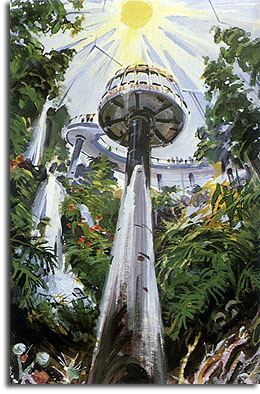 “LAND PAVILION: Among preliminary concepts is this experience, stressing harmony between man and his environment.”
“LAND PAVILION: Among preliminary concepts is this experience, stressing harmony between man and his environment.”The Land Pavilion will graphically illustrate man’s role as a “protector” of this finite resource, as well as his alternatives and choices in maintaining, and even enhancing, the delicate balance within the natural environment. Through a variety of exciting and informative shows and experiences, guests will be introduced to the basic concepts essential for understanding the need for harmony between man and his home on “The Land.”
Transportation
 “TRANSPORTATION PAVILION: A concept for “hands-on” experience with working prototype vehicles of the future will be a part of this guest experience.”
“TRANSPORTATION PAVILION: A concept for “hands-on” experience with working prototype vehicles of the future will be a part of this guest experience.”This early version of EPCOT’s Transportation-themed pavilion bears many similarities to its successor, the World of Motion. The round building is somewhat familiar, as is the open central courtyard. This design is a lot more busy, though, and there’s a lot more going on – from the full-scale STS orbiter hanging over the courtyard to the external vehicle track. While this version of the pavilion features a dark ride similar to what guests would eventually ride in the real park, it seems that there was an additional attraction where guests were allowed to ride some sort of “futuristic” prototype vehicle. Little is publicly known about this facet of the ride, but some renderings seem to look not unsimilar to the current Test Track.
The Transportation Pavilion will show how man has progressed through time in direct relation to his ability to move from one location to another. Visitors will see man’s earliest and most humble designs grow and change as he reaches out to explore the world around him. They’ll be treated to simulated trips aboard some of today’s modes of transportation … and have a glimpse at future transportation systems … including a “hands-on” involvement with working prototypes of tomorrow’s vehicles.
Space
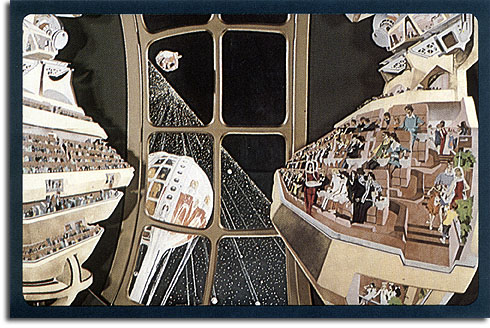 Rendering of the massive “space vehicle” that would be the feature attraction of EPCOT’s fabled Space pavilion
Rendering of the massive “space vehicle” that would be the feature attraction of EPCOT’s fabled Space pavilionOh, the Space pavilion. If anything puts a wistful look in the eye of a true EPCOT geek, it’s a mention of the Space pavilion. This grand, massive attraction was announced for EPCOT early on, and later slipped to phase II status behind Life & Health. It never saw the light of day.
Little is really known about this pavilion, but not for lack of fan curiosity. Produced with the assistance of author Ray Bradbury, the centerpiece of this pavilion would have been a massive simulator attraction that would have moved an entire theater in sync with outer-space visuals.
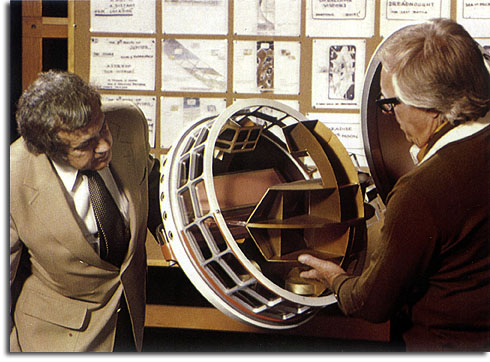 “SPACE PAVILION: Designer John De Cuir, Sr. and Writer Ray Bradbury discuss the model of the interstellar “Space Vehicle” which will highlight this pavilion.”
“SPACE PAVILION: Designer John De Cuir, Sr. and Writer Ray Bradbury discuss the model of the interstellar “Space Vehicle” which will highlight this pavilion.”A huge, interstellar “Space Vehicle” will transport passengers to the outer frontiers of the universe, highlighting man’s efforts to reach out for the stars around him … from the early pioneers who looked and wondered … to modern-day space travelers and their triumphs … to the challenges and possibilities of future space technology and exploration.
The Seas
 These now-famous renderings of The Seas were used to promote the much more elaborate earlier version of the pavilion through EPCOT Center’s opening in 1982 and even beyond
These now-famous renderings of The Seas were used to promote the much more elaborate earlier version of the pavilion through EPCOT Center’s opening in 1982 and even beyondThe Seas is another well-known missed opportunity for Disney fans. While The Living Seas did eventually open in 1986, years behind schedule due to difficulties in finding a suitable sponsor, it lacked the elaborate dark ride with its grand themes that would have served as a highlight of this original version. This early version also contains mention of an entirely separate attraction, featuring legendary mariners and their feats. Note, too, that one of the alternate concepts for the pavilion’s exterior is much more organic and rough than the final design.
Guests will board the clipper ship, “Spirit of Mankind,” to sail through moments of peril and triumph with seven legendary mariners … the great explorers who charted the seas for civilization. In another adventure, Poseidon the Sea Lord will challenge visitors to journey through the ocean depths … from the Continental Shelf to the Great Coral Reef. Finally arriving at “Sea Base Alpha,” guests will experience an authentic ocean environment with live marine life, an undersea restaurant, and a showcase of oceanographic exhibits and displays.
Energy Pavilion
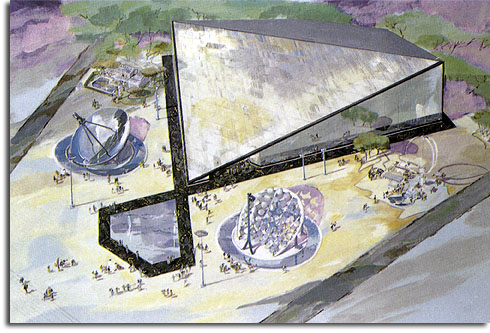 “PRACTICAL APPLICATIONS: The Energy Pavilion will feature demonstrations of solar energy applications.”
“PRACTICAL APPLICATIONS: The Energy Pavilion will feature demonstrations of solar energy applications.”Here’s another familiar face – the Energy pavilion. That angled, reflective wedge would survive the development process to become well-known to generations of EPCOT visitors. What’s funny, though, is that the model shown earlier depicts an entirely different version of the Energy pavilion design – a semi-circular bank of mirrors facing a central solar collector. That design would be shown prominently in various EPCOT promotional films during 1978, but as this rendering shows it was a competing concept that would win out in the end. Look closely, though, and you’ll see some details missing from the final design: various solar collectors, what appears to be a greenhouse, and a wind-powered turbine.
Even from the outside, the Energy Pavilion will be a strong visual statement as it generates power via its own solar energy systems. Here, the formation of fossil fuel energy will be portrayed, climaxed by a sudden energy storm of wind, lightening, rain, fire and volcanic eruptions, demonstrating the almost endless potential of raw energy available for man.
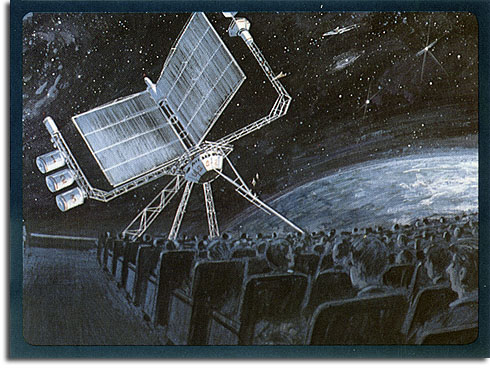 This early rendering of the Energy attraction shows how little it actually changed throughout its years of development
This early rendering of the Energy attraction shows how little it actually changed throughout its years of developmentThen visitors will see man overcoming the major crises of the past and finally the choices he must consider today … racing against the clock in a search for new energy, and finally harnessing tomorrow’s vast new sources for “The Future World of Energy.”
The American Adventure … Gateway to the WORLD SHOWCASE
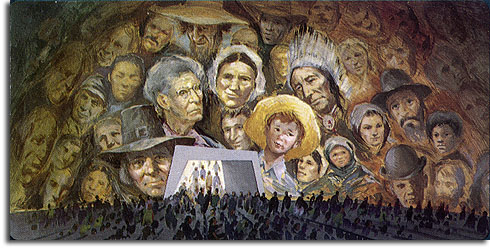 While the American Adventure attraction described in 1977 sounds familiar, its show building certainly wasn’t
While the American Adventure attraction described in 1977 sounds familiar, its show building certainly wasn’tBy this point in EPCOT’s development, Imagineers had a fairly good handle on what they wanted to do with The American Adventure. This was roughly the sixth concept that designers had proposed for the American pavilion, but it’s obviously similar to the attraction as it exists today – with two big differences. First, instead of its current location as host of World Showcase on the far side of the lagoon, it was located as a “bridge” between Future World and World Showcase. The positioning of the pavilion between these two realms affected its design; instead of the colonial bricks of the final show building, this version of the pavilion would have been housed in a then-current modernist structure. The other major difference in this early version was that in addition to Benjamin Franklin and Mark Twain, Will Rogers acted as a third host and representative of the 20th century. Fearing (sadly) that Rogers would be too obscure for modern audiences, Imagineers eventually relieved him of his hosting role and relegated him to a cameo.
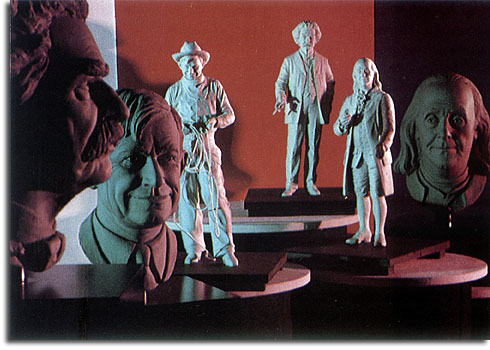 “AMERICAN ADVENTURE: These models and renderings picture the “main spokesmen” guests will meet as they experience the story of the American people: Benjamin Franklin, Mark Twain and Will Rogers.”
“AMERICAN ADVENTURE: These models and renderings picture the “main spokesmen” guests will meet as they experience the story of the American people: Benjamin Franklin, Mark Twain and Will Rogers.”“America has been settled by the people of all nations, all nations may claim her for heir own. We are not a narrow tribe of men … No: our blood is as the flood of the Amazon, made up of a thousand noble currents all pouring into one. We are not a nation so much as a world…”These words, written by Herman Melville, are the inspiration for The American Adventure – standing at the crossroads, facing onto the Future World and acting as the gateway and “host” to the nations of the World Showcase. Here, visitors will experience the remarkable three-century story of the American people, from the first step onto Plymouth Rock, to the first step onto the moon. Three of the most eloquent spokesmen in American history, Benjamin Franklin, Mark Twain, and Will Rogers, will lead a cast of performers “brought to life” through the Disney Audio-Animatronics process of three-dimensional animation. Their message is one of optimism for the future – that in their times too, American dreamed of a better tomorrow – and that a nation, founded in liberty and freedom, gives its citizens the opportunity and incentive to build on the great foundations of the past.
World Showcase
 Unlike earlier proposed versions of World Showcase, the design revealed in Master Plan 5 featured highly-themed national pavilions circling two large lagoons
Unlike earlier proposed versions of World Showcase, the design revealed in Master Plan 5 featured highly-themed national pavilions circling two large lagoonsDespite having been in development longer than Future World, little is said in 1977 about World Showcase. This is most likely due to the rather unsuccessful scramble to sign up national participants. As you can see in the model at the beginning of this story, World Showcase was rather optimistically designed to have two rows of countries, with plenty of room for several dozen national pavilions. This was not to be, of course.
The big breakthrough in Master Plan 5 was the idea that seems second-nature today – that the national pavilions would be housed in separate buildings around the lagoon, and that they should all have highly themed exteriors to match their national sponsor. This plan was the brainchild of Imagineer Harper Goff, and it flew in the face of the original World Showcase plans that called for the national pavilions to be housed adjacent to each other in very modern, featureless semi-circular structures. The pavilions would be well-themed on the inside, but to all outward appearances they would be identical.
Goff hated this idea, and envisioned a highly-themed area that would use well-known visual icons for each country, much like World Showcase does today. Try as he might, though, he couldn’t get it past Card Walker, who preferred the more modern approach to the area. Goff knew he was right, though, and one day when a number of potential international sponsors and investors were to tour Imagineering, Goff made sure to leave a number of his elaborate paintings of the forbidden World Showcase concept lying around in plain sight. Needless to say, the money men were smitten with Goff’s detailed and lush paintings and he won the argument by default.
In prior years, we have reported extensively on our concepts for the pavilions and exhibits of World Showcase. During this year, WED Imagineers, working with potential participating nations, have continued to refine these concepts creating many new renderings and models, some of which are shown here. In 1977, we have also developed an exciting new concept for the overall design of World Showcase which we are pleased to present publicly for the first time.
In this new interfacing design concept, countries from around the world will stand side-by-side in friendship along the banks of a broad lagoon … symbolic of the waters that bind together the diversified peoples of the world.
A “Community of Nations,” World Showcase will be the first permanent international exposition of its kind anywhere … communicating the culture, history, tourism and accomplishments of each participating country. Here, guests will visit a wide variety of exciting shows and ride through attractions, restaurants and shopping streets unique to the individual nations, and areas presenting travel and products of industry.
EPCOT Center’s World Showcase is a true people-to-people concept. Participating nations will be invited to send their outstanding young adults to operate the attractions, shops, restaurants and exhibits of their pavilion. And these young people will not only work together, they will also live, play and learn together. Many of these young adults will be future leaders of their countries. Their association and work experience in EPCOT Center could be a significant step toward generating greater understanding among the peoples of the world.
That last bit alludes to something that Card Walker mentioned often during these years – the hope that the international students coming to work at EPCOT would return as friends to lead their own nations. Walker often referred to his hopes that some day Israeli and Palestinian leaders, or U.S. presidents and Soviet premiers, could defuse global tensions as they reminisced about their days at EPCOT. It seems funny now, but it was a big part of how EPCOT was promoted in the 1970s.
 This Imagineering model for the Canadian pavilion is remarkably similar to the finished product except for a few things – first, that Quebecois flag would never fly in the real world, and also, if you look carefully… lumberjacks! I want lumberjacks!
This Imagineering model for the Canadian pavilion is remarkably similar to the finished product except for a few things – first, that Quebecois flag would never fly in the real world, and also, if you look carefully… lumberjacks! I want lumberjacks!EPCOT in 1977 might seem like a million years away from the park that would open in 1982, but for the first time it had really started to feel like a fully-formed idea and you can see the roots of many attractions that were to become fan favorites. Within the next year, Disney executives would commit to the idea, sponsors would come aboard, and throughout 1978 the idea of what EPCOT Center was to be became clearer and more real. And it all started with Master Plan 5.


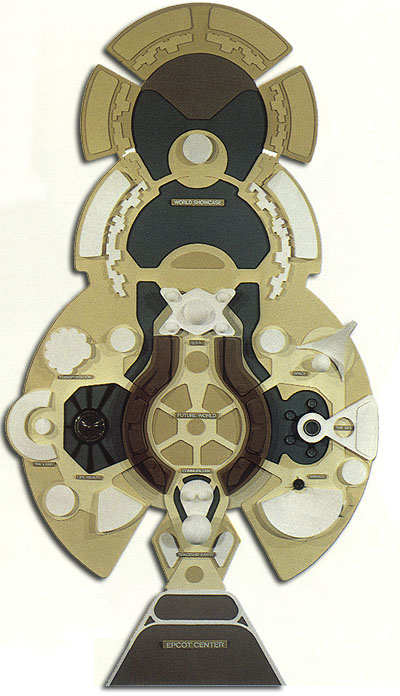

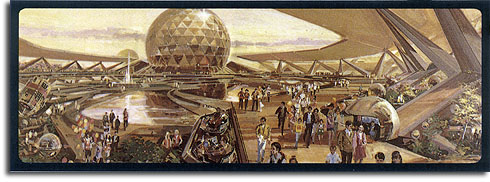

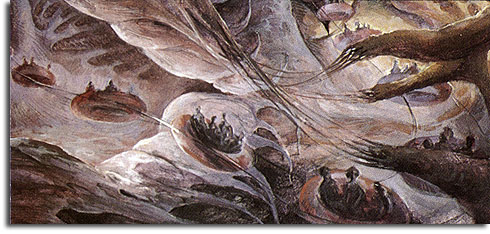

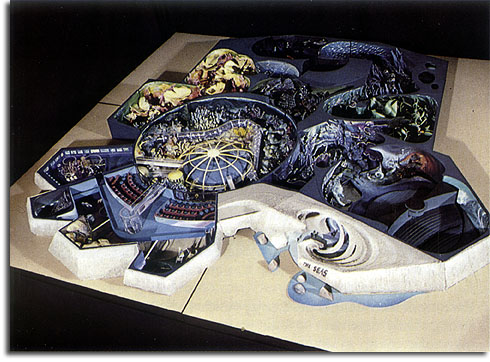
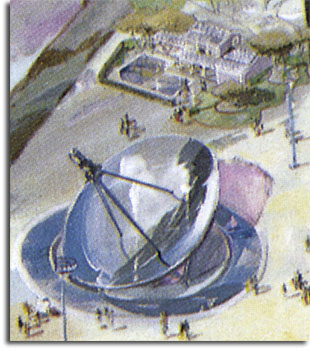



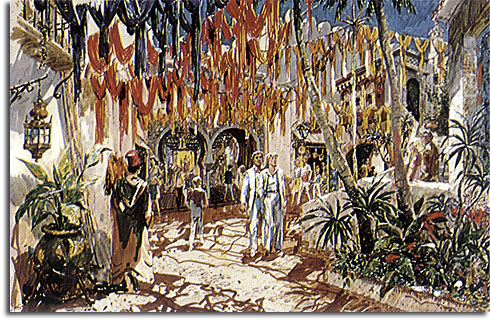










PS. Forgot to thank Celeste from The Lucky Orange for expediting the process with her photo-ninja skills
Fantastic article. Thanks!
Kudos!
Thank Celeste for all of us. She rocks!!!
You’re welcome George *lol*
I really like all the bizarre little people in the Canada model. They’re all waving and staring the guy who is apparently trying to get a kid off the rocks on the right. I’d like to recreate this photo with real people.
What about the kid in the yellow shirt that is wearing a…diaper?
C, maybe we should recreate these photos at the next Sweatbox!
Great article! Fantastic pix! I’m always amazed by some of the artwork that you (and others, too) find. Looking forward to the next one.
John DeCuir. Look at that insane theater. The man that invented “the wow”. Great piece. thank you.
[…] park was still just barely on the drawing boards. Don’t miss the Progress City, USA post on the origins of EPCOT. EPCOT Center’s path from concept to execution was, in so many ways, far more tortured than most […]
[…] the park was still just barely on the drawing boards. Don’t miss the Progress City, USA post on the origins of EPCOT. EPCOT Center’s path from concept to execution was, in so many ways, far more tortured than most […]
Thanks for a great article. It was fun to revisit this concept art that was all over WED when we started working on the engineering designs. It was definitely like trying to hit a moving target.
Thanks for the article. Very fun read and informative.
Thanks to everyone for their comments! I’m really glad you enjoyed it. (And special thanks for all the links we’ve received – new readers should, of course, follow us on Twitter, Facebook, and subscribe to the podcast )
)
Celeste: I was amused by the little Canada people too. They’re milling about in a very orderly way. I considered that they were standing in a circle to watch a rumble of some sort. But I’m really jealous that model EPCOT had lumberjacks!!
RO93461: If I’m not mistaken, his nickname was John “MFing” DeCuir haha… I know this was before your time, but I thought about emailing to ask if you ever heard / had any idea how that theater was supposed to work. I’ve seen film clips of them messing about with it but it looks totally insane. I’d love to know what they had in mind.
Steve A: Thanks so much for commenting! You’re always in perilous danger of being hit up for information too. I’m sure it was like trying to hit a moving target – George McGinnis has mentioned how new artwork and models were flying in and out all the time. How fluid do you recall things being? It’s hard to find two renderings or models with the same layout. What’s amazing is that some rare concepts stayed static throughout, while others seemed constantly in flux.
I’m sure it was like trying to hit a moving target – George McGinnis has mentioned how new artwork and models were flying in and out all the time. How fluid do you recall things being? It’s hard to find two renderings or models with the same layout. What’s amazing is that some rare concepts stayed static throughout, while others seemed constantly in flux.
And, since you’re here, do you have any recollection of the French movie being planned as Circlevision (per my previous story)?
Anyway, thanks again to everyone for reading!
Aaaaaahhhhhhh……
My head is going to explode from awesome-information overload!
GREAT post!
Thanks!!!!!!!!!!!!!!
I really enjoyed this article very much. I’m relatively new here, but I can tell that this will become one of my favorite blogs. A million thanks!
Wow! Fantastic article. Wonderful to see many of those early concept renderings & models for the first time.
[…] park was still just barely on the drawing boards. Don’t miss the Progress City, USA post on the origins of EPCOT. EPCOT Center’s path from concept to execution was, in so many ways, far more tortured than […]
Very good article. As well as providing insights to the developing concept of EPCOT, I got a better understanding of Card Walker, who he was and how he possibly interperted his leadership responsibilities towards the closing of the “what would walt do” period. Thanks Michael! C-ya’ — JJT
Awesome article. I’ve just finished reading Project Future (after seeing it on here) and this was the perfect mini-sequel!
Wow, great article. Good job, very informative and entertaining.
Hi Michael,
To give you an idea of how fluid things were, when we started designing the control systems for The American Adventure we thought the lifts were going to be on a turntable, not a carriage! Yet the building was already under construction!
My wife did France, and she doesn’t recall there ever being a plan to do a Circlevision there. According to her, from conception, the theater was always supposed to look like the Paris Opera House. Of course, some model maker might have just assumed it was another Circlevision and made that shape. There were constant shape changes on the model, even after construction started — something I can’t imagine happening on a theme park construction project these days. I guess that’s why $400M turned into $1.2B.
Best Wishes,
Steve
Great article. It is always interesting to get a glimpse of the design process and an understanding of how much goes into the parks we all enjoy. I am particularly impressed with the amount of concept art and models you were able to include. Thanks.
Great article, thanks a bunch! This is pure gold for paleofuturists like myself.
Oh my gosh guys, thanks for all the great comments and participation. I apologize for being a bit of an absentee host this last week or so; I like to respond when I can give things my full attention.
To all the new readers: Thanks for chiming in! Take a look through the archives; I hope you’ll like what you find. Please stick around and make yourselves at home, and feel free to speak up anytime! I’m really pleased that people are discussing things more and more around here, because it does make things more interesting.
MkyMtnMouseDude: I’m glad, because Card is one of those sort of vague figures who was there for so much but it’s really hard to get a feel as to what his agenda really was. I think a lot of people write him off (and some for good reason, especially on the Studio side), but I think his attitudes concerning WDW and EPCOT were a little more complex that many of us tend to think. I know I’ve learned a lot in recent years that’s definitely changed the way I look at the demise of EPCOT city and the rise of EPCOT Center.
Robin: Glad this filled in the blanks! There’s kind of a big “this page intentionally left blank” spot in EPCOT history from around 1968 to 1978, and I want to fill that in.
Steve A.: I can’t thank you enough for your comments – I’m really glad to have you contributing here because I think the engineering side of Imagineering is too often overlooked in lieu of the “pretty renderings/models” side of things. What I love about WED is that it pulled the best from both worlds at a time of such technological change. I love your book just because of that EPCOT feeling – the fact that everything was happening during the digital revolution, but everything was still so primitive that it had that kind of “hands on” feel.
That bit about American Adventure is just crazy. I can’t believe you guys pulled it off. Just this weekend I was watching the TV special from the 80s about the show, and it’s amazing how that attraction came together. There’s really not been enough written about the various original concepts and subsequent development of that pavilion, because after all these years it’s still one of a kind.
Thanks for the info on the France pavilion – I’ve always heard how fluid things were so I guess I’m not surprised.
Anyway, thanks again for chiming in and for “hanging out” – it’s a real thrill to be able to hear these things from the people that were actually there.
Also, I appreciate that I was about to use your book as a fact-check for my Denmark bathrooms story, so you helped me make Disney bathroom scholarship history
So thanks again everyone – I’m glad you enjoyed it! More, hopefully, soon!
[…] you are a big fan Walt Disney World’s EPCOT you will enjoy this article EPCOT: Origins – Master Plan 5, 1977 from Progress City, USA. Chock full of information and images of the original plans for what would […]
[…] megalopolitan visions brim with optimism, such as those of Walt Disney and Frank Lloyd Wright. Others, like the surrealist nightmares of Irving Norman and the Los Angeles […]
[…] are the original plans for Future World. This week Jim Hill shows us the original plans from the Disney 1977 Annual Report and I found The Land to be the most interesting. The Land of course is home to the legendary Living […]
I can not tell you how thankful I am to have found this. In two days I’m required to do a complete presentation on EPCOT. This article put everything into perspective and is overloaded with information I was unable to find after two hours of research. Thanks again.
[…] Epcot (more info) is a theme park in the Walt Disney World Resort, located near Orlando, Florida. The park is dedicated to the celebration of human achievement, namely international culture and technological innovation. […]
That was fascinating! Thanks for the insight.
[…] http://progresscityusa.com/2010/04/20/epcot-origins-1977-master-plan-5/ […]
[…] http://progresscityusa.com/2010/04/20/epcot-origins-1977-master-plan-5/ […]
[…] Michael at Progress City, USA takes an in-depth look at the 5th Master Plan for EPCOT Center. […]
[…] the latest technologies and materials with time-tested concepts about livable communities. Epcot’s radial design surrounded a high-density urban core with low-density neighborhoods; at its center was a 50-acre […]
[…] the latest technologies and materials with time-tested concepts about livable communities. Epcot’s radial design surrounded a high-density urban core with low-density neighborhoods; at its center was a 50-acre […]
[…] as tecnologias e materiais mais recentes com conceitos comprovados sobre comunidades habitáveis. Design radial do Epcot cercou um núcleo urbano de alta densidade com bairros de baixa densidade; no centro ficava uma […]
[…] informazioni: D23 (1, 2, 3, 4, 5) | Mainst Gazzette | progresscityusa | imaginerding | allears | MCmicrocomputer | Wikipedia | Theme Indez and Museum Index: The Global […]
[…] Michael. “EPCOT: Origins—Master Plan 5, 1977.” Progress City, U.S.A. (website), April 20, […]